Polyester vs Nylon Fabrics — When Wet
We use 100% polyester fabrics on the MoonLight tents. They cost more than similar nylon fabrics so we better have a pretty good reason to use them.
We do: it makes our tents completely sag proof. In fact, and it's taken me years to appreciate the full truth of this, our tents are unperturbable, unchanging objects. Wet or dry, fresh out of the bag or setup-for-days, they always look exactly the same without needing re-adjusting or fiddling. You can literally set 'em and forget 'em.
Nylon fabrics, on the other hand, are almost the exact opposite: when nylon gets wet, it absorbs water and expands 3.5% in length (2% for nylon 6,6 - "high tenacity nylon"). Polyester absorbs just a few tenths of a percent water and doesn't seem to grow or shrink AT ALL. Three and a half percent doesn't sound like much, but if you do the math it's dramatic. Small tents have at least one fabric dimension over 120" long that will shrink and expand 4” from full dry to full wet – that's 2" per corner edge on a rainfly – a number that I think lots of experienced backpackers will recognize as a typical amount they have to tighten a rainfly when it gets rained on.
Virtually all tents are made in Asia. It's where all the sewing talent is for all the super-lightweight fabrics, it's where most inexpensive fabrics are produced, and the humidity is perpetually high. So all tents made there are patterned and manufactured in high humidity conditions. If one of those tents comes to a dry climate like the Western US, that tent's fabric shrinks 3.5% in all directions. From a manufacturer's point of view, this gets tricky, especially for the rainfly. Two person backpacking tents can be carefully patterned to be a little loose in high humidity and a little tight in low humidity. With a little fudging, the customer has tent that they can set up as functioning, decent looking tent pretty much every time. But when conditions change, they have to tighten or loosen the pitch accordingly. Unfortunately that means if it rains in the middle of the night, nylon tents sag badly (see photos below) and the wrinkles drip condensation onto the sleeping occupants until they get up and fix it.
This situation isn't manageable for large tents. You can't make a large nylon tent that sets up decently in a high humidity environment that can also be set up decently in dry conditions. Running the numbers, a big tent can easily have 8" of size change - 4" per corner - and it's just plain too much change - the fabric no longer fits the frame no matter how much one tries to adjust the pitch*. It has taken more than a decade for some manufacturers to find the polyester solution but now it's the norm for large tents. Take a look, almost every quality manufacturer of large tents uses polyester for the majority of their tent fabrics.
Some polyester tents still use nylon for the floors with the explanation that it has higher tear strength. If those manufacturers were actually getting data to evaluate how much tear strength a floor needs, that might be a fine thing to say. But they don't have that information, not at all. Instead they say, "What we've been using isn't causing complaints so we're going to just stick with it." I really think those manufacturers should re-evaluate that because the floor size is a really big part of the spec (and promise) of a tent. A 3.5% shrink in the length and width is a 7% shrink in area! Shouldn't a tent manufacturer be giving the (dry) minimum dimensions of their tent floors? As a customer, if I've decided I can use a tent with an 88"x48" floor, I don't think it's OK for it to actually measure 85"x46.5" when I go out to use it.
Another really nice thing about polyester is that since it absorbs less water, it dries faster AND, of course, it weighs less when it's wet.
I think there is some idea out there that perhaps siliconed nylon - those with a Sil/PU** finish - might be immune from nylon's expansion when wet. The thought is that maybe the nylon is sealed off from the outside water. Sadly this is not the case because silicone is extremely porous to water vapor. So the nylon expands just with a Sil/PU fabric as a regular PU+water repellency treatment. Here's a shocking quote from a water vapor test equipment manufacturer (thanks for the ref Tim!):
"Silicone... is an excellent barrier against liquids, but many vapours – such as oxygen, water vapour and hydrogen can pass through most types of silicone almost as if it was not there."
* Back in the day, I personally felt the the big wet slap of nylon in large tent production: I approved tents that looked beautiful at the factory. They were perfect and I did what many a product manager before me had done – I approved the sample for production. But when the production came in to the US warehouse, they couldn't even be setup without cutting the poles down — it was a major nightmare! Every tent had to be unpacked, have its poles cut and then be repacked.
** Sil/PU means Silicone/Polyurethane where one side is siliconed and the other is polyurethane coated. Note the we use sil/PEU on our polyester fabrics. PEU is a polyether based PU that is extremely stable and durable – no stinking, peeling or sticking PU coatings for us, thank you.
What this all means is that when you pitch a NYLON tent and it looks beautifully setup and taut like this:
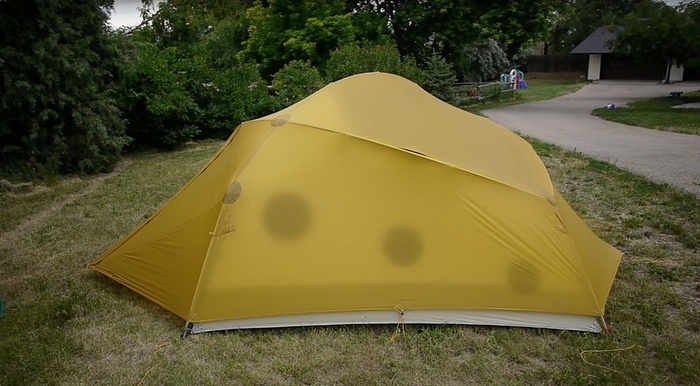
Nylon sil/PU rainfly on a prototype MoonLight 4 - DRY MoonLight 4+
When it rains, it sags and looks like this, causing massive condensation, dripping on the inside, and flapping in winds:
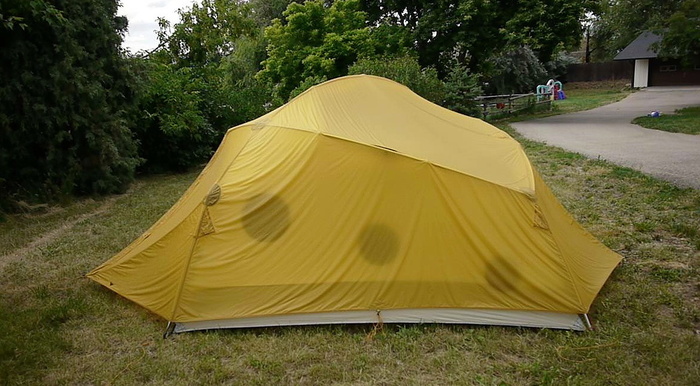
Nylon sil/pu coated rainfly on the same prototype MoonLight 4 (after just 4 1/2 minutes of spraying down with a hose)
But the same tent with a polyester rainfly doesn't sag when wet:

A Polyester rainfly before and after (8 min hosing) - boring but good. By the way, the polyester fabric on this particular prototype didn't have an exterior silicone treatment. It was just polyurethane on the underside. All our current fabrics are sil/pu with silicone on the outside plus polyurethane on the underside. They repel water really well and they don't let it through.
Talk about stoic! Backpackers have put up with this sagging for DECADES. This probably explains a lot to you experienced tent users out there. You knew something like this must be going on. But you dutifully went out to re-tighten everything in the middle of the night so it wouldn't flap and drip. But it wasn't your pitch job coming loose or fabric stretch or the weight of the water on the fly or anything like that – it was just the nylon expanding because it got wet (probably also made worse by nylon guyline cords). Pretty shocking and completely unacceptable for our purposes here: to have the ultimate no fuss, set-it-and-forget-it tent.
Now that sagging and stretching nylon is outed, it can be understood as a tradeoff that ultralight backpackers must make (in 2018, still) to have the absolute lightest tents possible. Tent-worthy polyesters currently only go down to 20D fabric weights. Nylon fabrics are available all the way down to 7D.
Why don't other brands use and promote lightweight polyester fabrics?
I’ve been thinking about how to say this exactly right and I think I’ve finally got it:There are two kinds of brands, ones that "go with the flow" and do what is normal and expected (usually for a good price) and ones that are pushing the marketplace with their voice to champion certain features and benefits (for which they rightfully get a higher price). Right now the ones pushing are selling the lightest tents possible which are therefore made from 7D, 10D and 15D nylon fabrics. The weights of these nylon fabrics are lower than available lightweight polyesters – currently 20D is the lightest for polyester*. So the lightest polyester fabrics are in a no-man’s land marketing-wise. The feature being talked about by brands that push is the lowest possible weight. Polyester fabrics don’t offer that advantage so they’re out. Plus there’s the problem that if a push-brand decided to sell the advantages of polyester, they would be also be saying that their top-end tents were actually not that great.
Meanwhile, go-with-the-flow brands mostly sell tents in the $200 range (for two people), made out of 68D and 75D polyester fabrics because of the excellent value those fabrics offer. For their marketing and customer, tents made from 20D polyesters are far too difficult and too expensive to sell. You see how this plays out: no 20D polyester for anyone but fanatics (me).
There's one more reason why some manufacturer's stay away from polyester: the specter of color transfer. It's kind of a boogeyman thing – no-one points to a specific reason it happens, only that it could, especially if a dark color is put next to a light one. Yet, despite it's monster-under-the-bed status, ALL the big tents in the camping world use polyester and they seem to do just fine. We've taken the approach that sagging when wet is completely unacceptable and we're willing to manage our fabric suppliers to ensure that the colors don't bleed (and we also have chosen colors that would be hard to even know if there was any bleeding of one onto the other).
Here's the video that the photos above are from. BTW this video shows what about 2-3% expansion does. I didn't start with 100% dry fabric nor finish it 100% soaked (which would have taken longer):
I’m the first to admit that this page might come off a little strident. I mean, how bad could nylon be if people have been using it without complaint for many years? From what I’ve seen the answer, frankly, is “pretty bad.” Take a look at the photos below which show some dry-to-wet photos of nylon tents. I don’t know about you but I’m not putting up with it any more.
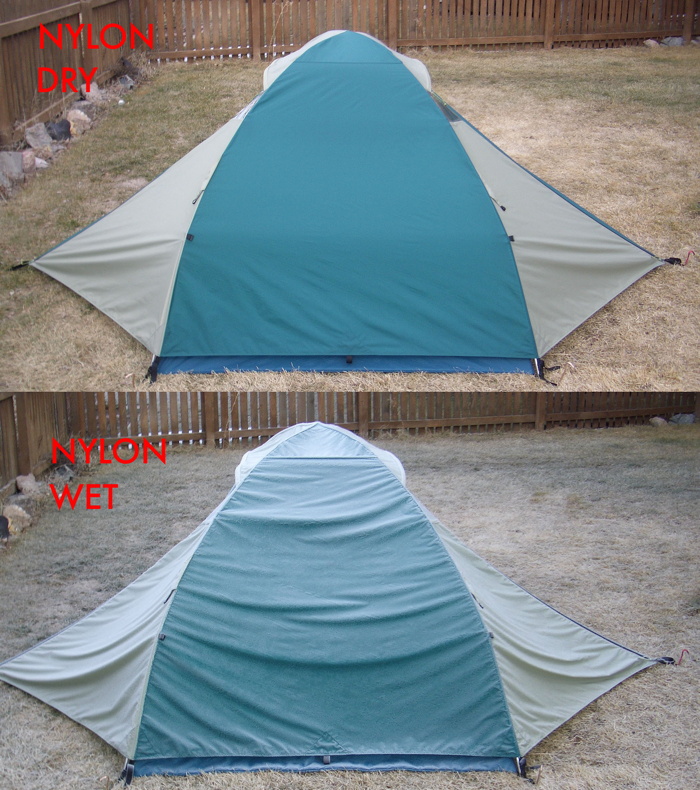
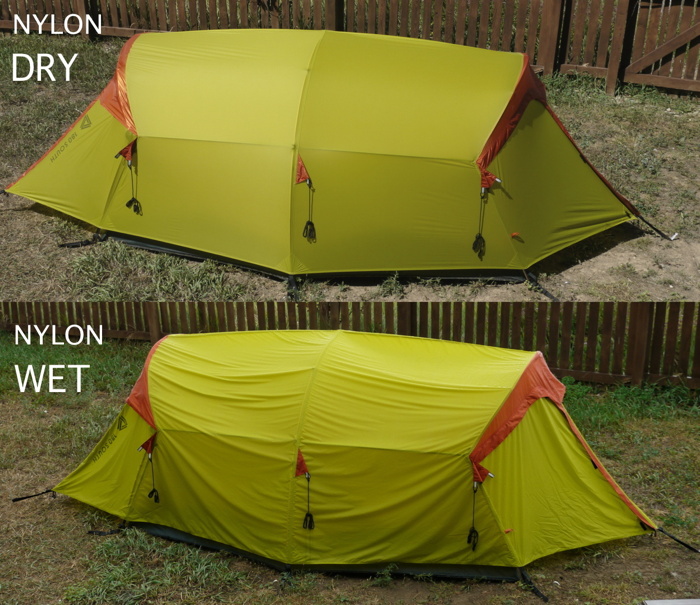
Scenes like this happen everywhere when it rains. It's the nylon…and YES, those wrinkles drip condensation inside really badly.
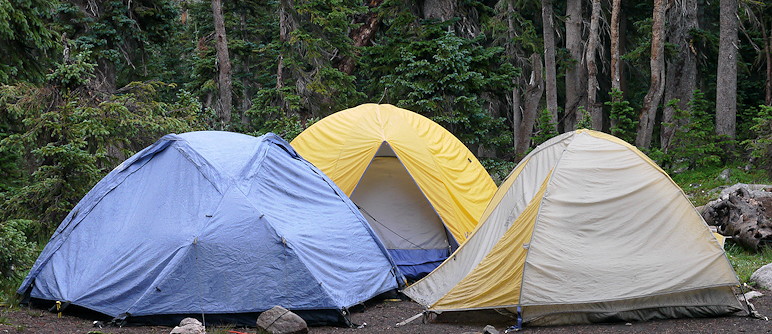
I saw this happening at a trade show where all the latest tents were out. It was just starting to sprinkle a little…
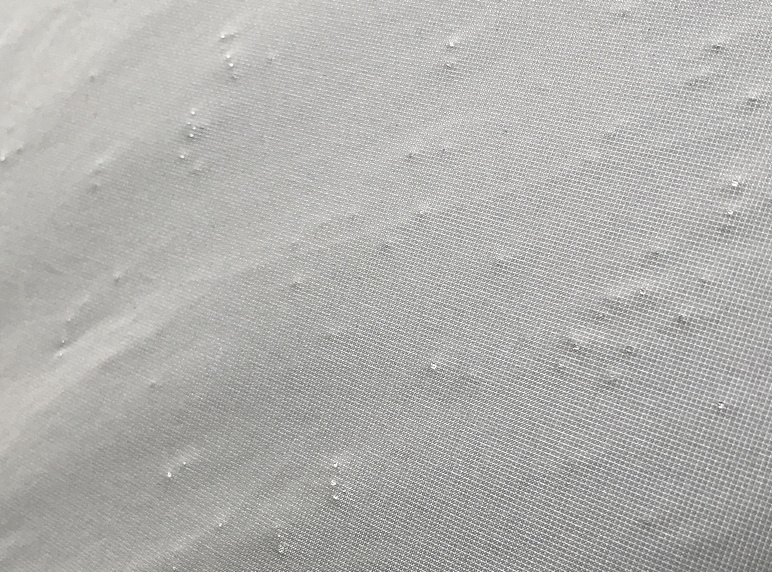
This particular tent rainfly was a super-ultralight tent made of 10D nylon with a sil/pu finish. Rain droplets were causing little bumps to form on the fabric as the nylon expanded under them. Lovely and kind of striking to be walking around in a sea of tents that were all getting acne while the company reps and outdoor retailers present completely missed the sight. They literally didn't see it – it's the reverse of "out of sight is out of mind". As anyone who studies cognition can tell you: out of mind is almost always out of sight. Or, put another way, you can't see what you don't know to look for.
I mean…YEESH!
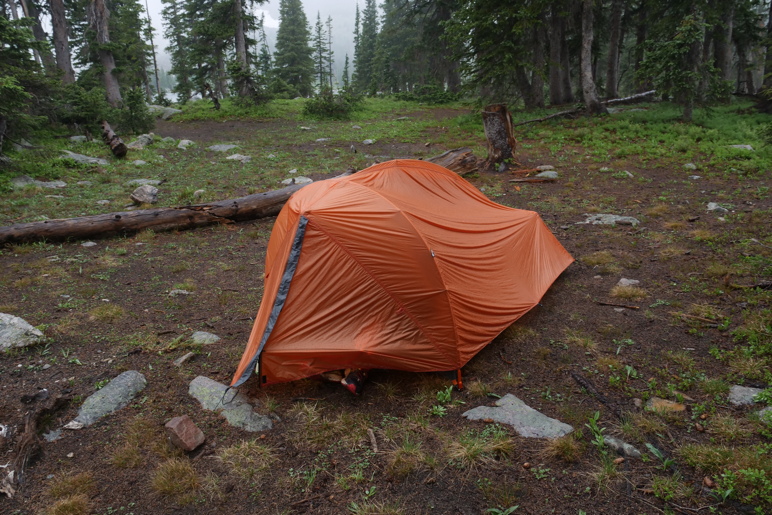
* Our coated fabrics are 30D because our supplier actually couldn't make coated 20D lighter than their coated 30D. It doesn't make sense but welcome to the world of manufacturing – so we went with the stronger and lighter 30D.
